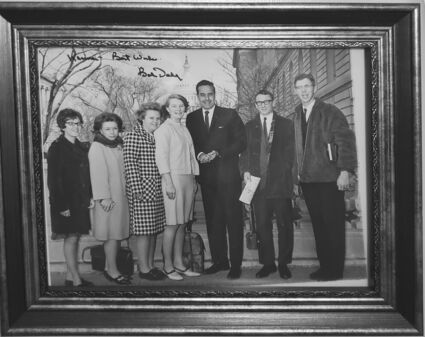Editor's Notebook
December 9, 2021
When Highway 14’s concrete bridge over the Republican River, fell into the river, the State of Nebraska chose to replace it with a smaller bridge. The replacement was said to be temporary as it would be replaced when funding became available to construct an overpass over the Burlington and Missouri Pacific railroad tracks. At the time the Burlington line was considered the company’s main line connecting Kansas City and Denver. There were a number of scheduled passenger and freight trains over the line each day and on some days there were a dozen or more special trains. Many of the specials were hauling livestock to the Kansas City market. We may not have as many trains today but the trains we have are much longer.
With the construction of Hastings ammunition depot, traffic on the Missouri Pacific line sparked upward and it became the best maintained line of those serving Superior. That was a good thing for many of the trains hauled explosives, I don’t remember hearing of an explosion associated with a train derailment but the Omaha World-Herald published numerous reports of exploding Watson Brothers’ trucks loaded with explosives.
One year I was given a toy Watson Brothers semi-truck. With a Watson Brothers truck in my toy collection, my playtime included many explosions.
Apparently the state roads department no longer plans a Highway 14 overpass at Superior. The temporary bridge has been replaced with a larger bridge and the highway alignment changed to eliminate the sharp corner that was just north of the tracks.
Last month’s week long closure of the Highway 14 crossing demonstrates the need for an overpass. Though the alternative route was not the best, there was an alternative. That will not always be the case. With today’s long trains, stop one in the right place and it is possible to block all crossings. The nearest alternatives would be either Hardy or Bostwick.

For the most recent closure, the official detour route included Highways 36, 128, 78 and 136. Had the three in-town crossings been blocked, an emergency vehicle responding to a call in the south part of Superior, the official detour would have added about 60 miles to what normally would have been much shorter trip.
The combination of a Highway 14 overpass and a road along the south side of the railroad connecting Central Avenue and Highway 14 would help insure access to not only south Superior but also northern Jewell County.
Don’t expect that construction project to happen anytime soon for it would cost millions of dollars.
I’ve taken a long detour to provide the back ground for my next statement.
I don’t know why the Hastings City Council is intent on removing the old Highway 281 viaduct over the Union Pacific Railroad. Neither can a group of Hastings citizens who have been opposing the action.
From my vantage point 60 miles away, that viaduct provides a valuable alternative way to get over one of the nation’s busiest railroad corridors and it should be maintained.
Hastings has more alternative ways over the railroad than does Superior but when you already have a viaduct, why remove it?

Before the current Highway 14 overpass was built over the Burlington line north of Highway 6, Highway 14 was routed underneath the railroad. That underpass is outdated and not suited for today’s trucks but it hasn’t been removed. When going north to visit relatives at Albion, I sometimes take the old route and remember what it was like to make the trip with my grandparents 60 years ago. In those days many of the miles were surfaced with gravel and there were more at-grade railroad crossings.
Now the Nebraska Department of Roads is considering constructing a Highway 14 overpass at Central City. Hopefully, that project will soon come to pass and join the two other overpasses and one underpass I have seen built on the Highway 14 route between Superior and Albion.
And while we are thinking about overpasses and viaducts, what is the difference? We have overpasses on Highway 14 but Hastings has a viaduct? Both allow motor vehicles to pass over a railroad without having to yield for a train. An underpass allows vehicles to pass beneath the railroad.
In searching for the answer, I learned a viaduct is a bridge with several spans that carries road or rail traffic over a valley or other obstacle while an overpass is a section of a road or path over an obstacle, especially another road or railway.
And there you have it. But I still don’t understand the difference. The Hastings viaduct has several spans but I don’t remember it crossing a valley. The Highway 14 overpass over the Kyle Railroad, about 16 miles south of Superior, has at least three spans over a man-made valley and railroad track. The highway was closed for several months in the 1960s when a derailment took out the span supports.
————
To shift gears a bit, the death this week of Bob Dole sparked memories of past presidential campaigns.
I still sometimes wear a Bob Dole T-shirt this newspaper screen printing department made to promote the Kansan’s bid for the Presidency. A Dole support had us print several shirt designs which were sold at the Kansas State Fair and other locations in Kansas.
When Dole was Gerald Ford’s running mate and spoke at a campaign stop at Hastings, my father and I went to Hastings to hear him and experience the emotion associated with a Presidential campaign.
It wasn’t the first time I saw Bob Dole or the first time I experienced a Presidential Campaign speech but I haven’t forgotten it.
As a Kansas State University student, I was privileged to hear and photograph Robert Kennedy announce he was launching a campaign for the office of President. I also heard and photographed Ronald Reagan and Nelson Rockefeller as they gave campaign speeches and was in the audience when George Romney delivered a campaign speech. It was several years after he sought the Presidency but I also heard Alf Landon speak about politics and have heard campaign speeches given by a number of people seeking Kansas and Nebraska offices.
My first exposure to someone seeking a position in Washington came as a member of the Webber Wide-Awake 4-H Club. As I remember it was a miserable night out when the club met in the basement of the Webber Methodist Church.
The meeting was underway when the door opened. I turned to see who was arriving late. To my surprise, it was Bus Boyd, the editor of the Jewell County Record, and another man I didn’t know.
The meeting stopped and Boyd apologized for interrupting and explained he was in the area helping his companion, Bob Dole, a candidate seeking election to the U.S. House of Representatives.
Like Boyd, Dole was kind as he talked with the 4-H members. He was the first “politician” I ever met. I didn’t consider the Boyds and others in these parts like Esther Hunter at Superior and Calvin James at Jewell to be politicians of the same class as those running for national office. Later I was to listen as either Bus or his brother Huck tell of seeing the lights burning late in the Russell county courthouse attorney’s office and concluding the young Bob Dole would make a good candidate for Congress. They were right and certainly picked a good man to support.







Reader Comments(0)